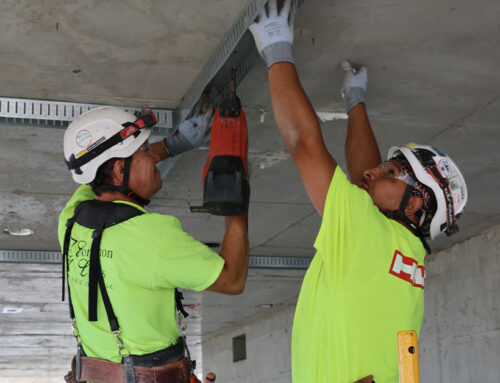Chris Mambu Rasch: Tell us about your new role with IBEW Local 494 and how you got to this point in your career.
John Jacobs: I officially started my role as IBEW Local 494’s Business Manager on July 1st and I’ll be fulfilling the remaining term until elections take place in 2025. I joined Local 494 in 1994 when I started my apprenticeship and became a journeyman wireman or JW. After I graduated, a local business representative asked me if I’d like to join the apprenticeship committee and I figured it would be a great opportunity. People were seeing things in me that I didn’t necessarily see in myself at the time, but I’m glad they did, and it started with me getting involved with my union and being active.
Before I was on any committees, it really just started with attending union meetings. I felt it was the right thing to do in taking an interest in the union I was part of and volunteered to be involved. Fast forward, in 2009 I was appointed as a Business Representative for the greater Fond du Lac area and then in 2015, Dean Warsh, Local 494’s former Business Manager, asked that I join the Milwaukee office.
As with the other roles I’ve held, I figured this would be a great way to challenge myself and take on more responsibility. My path has really built me up to take on the next role and every role I take, I take it seriously because of the respect I have for our members and the work we do. I’m excited to take my 29 years of experience with the IBEW Local 494 to this new role as Business Manager to serve our members and grow our Local to the best of my ability.
Chris Mambu Rasch: Who does IBEW Local 494 represent?
John Jacobs: Our jurisdiction on the construction side is the seven counties of; Milwaukee, Waukesha, Washington, Ozaukee, Sheboygan, Fond Lac and the Eastern part of Dodge County. We represent workers that manufacture lights, electric motors, control panels, electric signs, material handlers and on the construction side, low voltage residential and journeyman wireman. We also represent the workers of the Democratic Party of Wisconsin, Miller Brewery, Veolia electricians and most recently the workers at Colectivo Coffee, Wisconsin Progress and the Tammy Baldwin for Senate campaign. Numbers wise, we have about 2600 members total and we’re continuing to grow.
Chris Mambu Rasch: Why do you think your membership is steadily growing?
John Jacobs: For unions in general, I think it’s finally catching on that workers understand their importance with their employer. Workers have a seat at the table to discuss things with their employer in solidarity with their coworkers and realize that a collective bargaining agreement (CBA) is a legal binding document that protects and empowers them in that process.
For Colectivo, the pandemic brought on safety concerns because they still had to interact with customers and their asks weren’t being listened to. There was discussion about which union to join, and they ultimately came to Local 494, interviewed us and because we could represent all their workers, the warehouse drivers, cafe baristas, you name it, they chose to form a union with IBEW Local 494. It started with the workers, and we were approached.
Chris Mambu Rasch: What are some hot topics within the electrical industry?
John Jacobs: The world in which we live in is really exciting because the electrification of the energy sector is really taking off. In the near future, we’ll see an “electrical revolution” with generations of work. In my 29 years as an electrician, I have not heard that term used before. We’re excited about the whirlwind of opportunities this presents for our members and our signatory contractors. In terms of actual work, wind towers, battery storage, electric vehicle charging, and solar are really taking off throughout the state and the incentives from the Inflation Reduction Act are creating a tremendous amount of opportunity for our members and our union.
Chris Mambu Rasch: Given the monumental shift we’re seeing in the electrification of how we collect, store, and move energy, what do those in union construction need to do to position ourselves for the work?
John Jacobs: It comes down to training which is the sweet spot for unions. From residential electrical systems, to large manufacturing plants, technology is changing and Local 494 is making sure that our apprentices and Journey Workers are educated on the latest changes. All of Local 494’s apprentices now get certified in EVITP (Electric Vehicle Infrastructure Training Program) so that they can install EV charging equipment as part of our apprenticeship program. For unions, the key piece of innovating and tackling this amount of work is education. If you don’t stay on top of it, you’re not going to get the work.
It also comes down to a partnership with our contractors because they’re seeing and bidding on the work that is out there. The partnerships and communication with our contractors are crucial to knowing what needs to be added to our apprenticeship program and continuing education opportunities. The international IBEW is also a tremendous resource for curriculum, where ideas can be shared from across the country.
Chris Mambu Rasch: With all of this work, do we have enough electricians to meet the challenge of the energy transformation?
John Jacobs: Our union’s number one priority with contractors is to supply labor. Right now, our members are busy and we consistently have at least 500 apprenticeship applicants each year with a waiting list for those wanting to enter the program, so we have the attention of the general public. Our plan is to continue promoting our trade to reinforce the depth and number of candidates. The upcoming class is the largest number of apprentices that we’ve seen in recent times. The union and our contractors are confident that there will be work for these apprentices in five years and beyond. The latest modeling says that by 2030, we will need around 80,000 more electricians nationwide, which is 7% growth. In Wisconsin, we’re predicted to see roughly 11% growth over the next seven years in Wisconsin.
Chris Mambu Rasch: The Inflation Reduction Act is in part what gives contractors and the union confidence that there will be new work for your new and current members. How do you think the Inflation Reduction Act has been transformative in helping move us to this energy revolution?
John Jacobs: In several ways, one is the tax incentive that’s tied to certain benchmarks that have to be met which leads to the apprenticeship program. That’s a direct connection to our local JATC. Contractors also see the specific bills that have passed, and the corresponding funds tied to them that’s leading to support for larger apprenticeship classes.
From the residential side, there are tax incentives coming through after the second quarter of 2024 for homeowners to do various upgrades. That means there’s an opportunity for Local 494 to expand our work in the residential market and increase our market share with residential contractors. For example, when a contractor comes in to help someone update their main electrical service to accommodate an electric vehicle, through tax incentives, homeowners have an opportunity to add solar or battery storage to maximize their homes overall efficiency. It’s leading to more opportunities at the residential level. We’re also hearing that it’s becoming commonplace to add EV chargers to new construction multi-family projects.
Chris Mambu Rasch: There’s really a radical shift in how we capture, store, transport and use energy that is happening quicker than people think it is. How can the union commercial construction industry position itself for success within the energy transformation?
John Jacobs: I believe we need to stay actively involved in state, local and national politics and government to make sure that new policy and legislation favors our industry and keeps the playing field fair. Regardless of the political party, we want to be involved and have our concerns listened to. We also look to our partner Community Based Organizations, like WRTP|BIG STEP, to spread the word about registered apprenticeship and RPP certification. Cities other than Milwaukee have begun to require RPP certification so that workers are building the communities they live in because it’s important to keep the money locally. This is yet another opportunity for contractors to become signatory to Local 494 and use local, experienced workers. So, we need to stay ahead of politics, be at the forefront of education, and look at expanding our work in the residential space.
Chris Mambu Rasch: What attracted you to the trades and IBEW Local 494?
John Jacobs: I went to Kettle Moraine High School and we were either approached by the military or colleges, so I ended up at Whitewater. While in college, I started roofing to pay for school, but I realized there’s no way my body can do this forever. My experience did help me realize that I liked building things. After talking to some family members who were Local 494 electricians, I decided to leave college and apply for the apprenticeship program. After two years, I was accepted into the program and started attending union meetings. I enjoyed learning about the business transactions and what folks were doing in our office. I was taking a vested interest in our organization and started volunteering and that got me noticed. I’ll never forget volunteering to put in the boards around the rink of the Blue Line Hockey arena in Fond du Lac.
To learn more, visit our Electricians Trades to see how you could be a part of the next “electrical revolution”.





